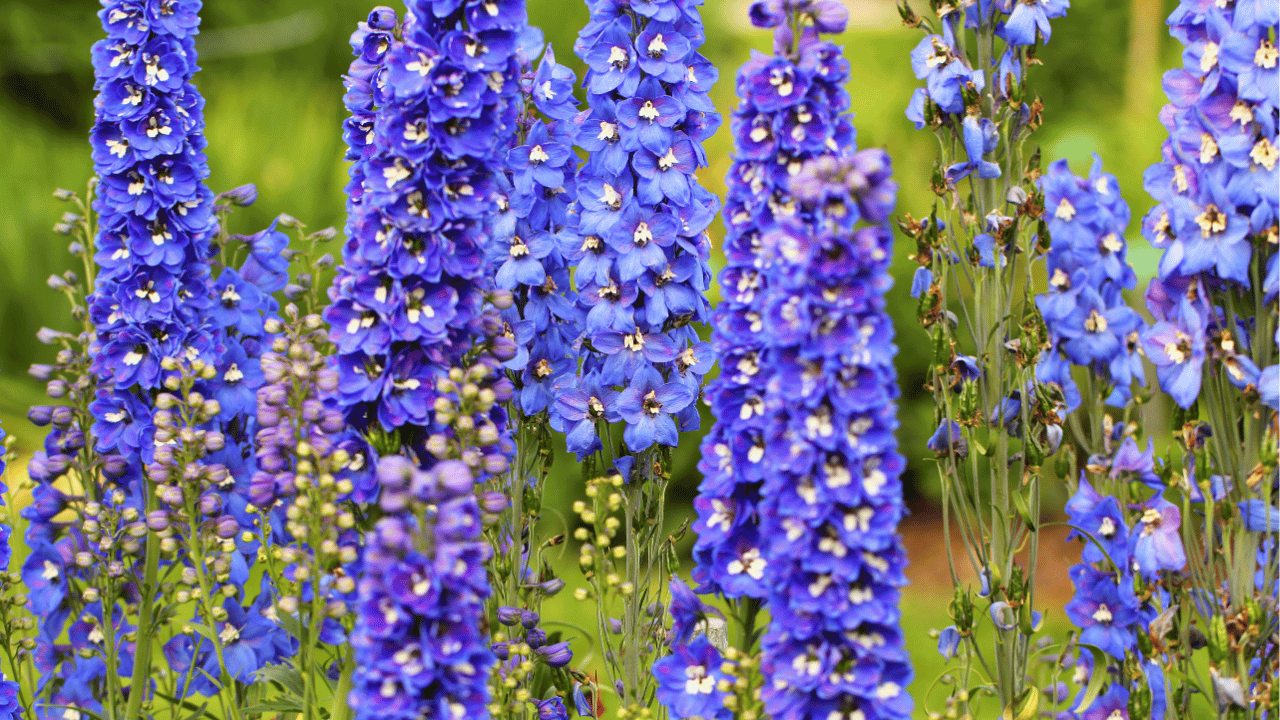Delphiniums are striking perennials known for their tall, spiky blooms in shades of blue, purple, pink, and white. While they make a stunning addition to any garden, they require diligent care and attention to thrive. By understanding their specific needs, from soil preferences to protection from pests, gardeners can ensure that their delphiniums grow strong, vibrant, and healthy. Below are ten essential tips to help you provide optimal care for your delphiniums.
1. Choose the Right Location
Delphiniums thrive in areas with full sun, yet they also benefit from some afternoon shade, especially in hotter climates. A spot with morning sun and light afternoon shade will prevent the blooms from wilting too quickly. Make sure your delphiniums aren’t crowded by other plants, as they need space for air circulation to avoid mold and fungal issues.
If your garden experiences strong winds, it’s advisable to place them in a sheltered location. Their tall stalks can easily snap in harsh conditions, so ensure there’s protection from wind, such as near a fence or garden structure.
2. Plant in Well-Drained Soil
Delphiniums prefer well-drained soil, rich in organic matter. A loamy soil that’s not too compact will help their roots spread effectively and access nutrients. Incorporate compost or well-rotted manure into the planting site to improve fertility and drainage, ensuring long-lasting bloom vitality.
Soggy soil can be detrimental, leading to root rot, so avoid areas prone to waterlogging. Raised beds or mounding up the soil can be beneficial in areas with poor drainage to keep their roots healthy.
3. Water Regularly but Avoid Overwatering
Delphiniums require consistent moisture, especially during hot, dry spells. Water deeply at least once a week, ensuring the soil is moist several inches down. Shallow watering promotes weak roots, so it’s important to saturate the root zone each time.
However, overwatering can lead to fungal diseases or root rot. It’s crucial to allow the top inch of soil to dry between waterings, which can be monitored with a moisture meter or simply by feeling the soil.
4. Stake Tall Varieties Early
Due to their height, delphiniums can become top-heavy, especially when in full bloom. To prevent the stems from bending or snapping, stake your plants early in the growing season. Use sturdy stakes that are 4-6 feet tall, placing them close to the main stem without damaging the root system.
As the plant grows, gently tie the stems to the stake with soft twine or plant ties, leaving room for growth. This support system will keep your delphiniums upright and showcase their stunning floral spikes.
5. Fertilize Regularly for Vigorous Growth
Delphiniums are heavy feeders, requiring consistent fertilization throughout the growing season. Apply a balanced fertilizer (such as a 10-10-10 mix) in early spring, then continue with monthly feedings to promote lush foliage and vibrant blooms.
Consider using a slow-release fertilizer, which will provide a steady supply of nutrients over time. Be careful not to over-fertilize, as this can cause the plant to produce more leaves than flowers, diminishing its visual impact.
6. Prune After Flowering to Encourage Rebloom
Once the first flush of blooms fades, cut back the flower spikes to just above the healthy foliage. This encourages a second bloom later in the season, providing a longer display of color. Pruning also prevents the plant from wasting energy on seed production, allowing it to focus on root and shoot growth.
Be sure to use clean, sharp pruning shears to avoid damaging the plant or spreading disease. After pruning, apply a light dose of fertilizer to encourage a fresh wave of growth.
7. Watch Out for Slugs and Snails
Slugs and snails can cause serious damage to delphiniums, especially during early growth stages. These pests love to feed on tender new shoots, often decimating the plants overnight. Use slug pellets, copper tape, or natural predators like ground beetles to keep the population under control.
Check the plants regularly, especially after rain or watering, when slugs are most active. Hand-picking them off the plants can be an effective measure, though it requires consistent vigilance.
8. Protect Against Powdery Mildew
Powdery mildew is a common issue with delphiniums, especially in humid conditions or poorly ventilated areas. Ensure good air circulation around your plants by spacing them properly and removing any nearby weeds or overcrowding. Mildew thrives in shady, damp environments, so avoid overhead watering to keep foliage dry.
If mildew appears, remove affected leaves immediately, and treat the plant with an organic fungicide. You can also spray a homemade solution of water and baking soda to control the spread.
9. Mulch to Retain Moisture and Control Weeds
Mulching around the base of your delphiniums helps retain moisture in the soil, keeping the roots cool and reducing the need for frequent watering. Organic mulches like compost, leaf mold, or straw are ideal, as they also break down and improve soil quality over time.
Additionally, mulch suppresses weeds that can compete with delphiniums for nutrients and water. Apply a 2-3 inch layer of mulch, making sure to keep it away from direct contact with the stems to avoid rot.
10. Divide Every Few Years for Healthier Plants
Delphiniums benefit from being divided every 2-3 years, as overcrowded plants can weaken and produce fewer blooms. Early spring is the best time to divide, when the plants are just starting to grow. Carefully dig up the entire clump and separate the younger, healthier portions from the older, woody sections.
Replant the divisions in fresh, well-prepared soil, and water them thoroughly to help them establish. Dividing not only promotes better blooming but also helps control the size of your plants in the garden.

